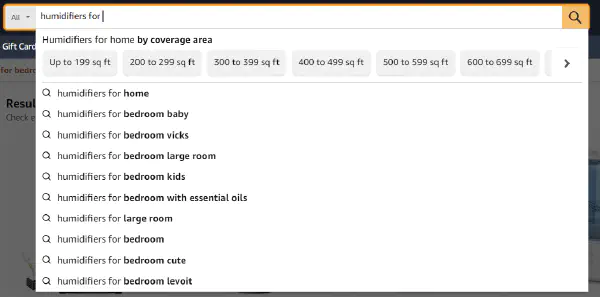In today’s digital marketplace, optimizing your ecommerce store’s site search functionality is no longer a luxury — it’s a necessity.
Currently, 39% of online purchases come from a relevant search. (Keyword: relevant.)
That’s why selecting a search tool that delivers user-relevant results cannot be overstated.
But how can you navigate the vast sea of ecommerce search solutions to find the right fit for your business needs?
Essential Features for an Ecommerce Site Search Tool
When evaluating site search solutions, prioritize the following features to ensure your tool not only meets industry standards but also offers a seamless and effective search experience for your customers:
#1 Rich autocomplete
An effective autocomplete can boost your conversions by as much as 24%.
This feature proactively suggests keywords and products based on real-time user input, significantly enhancing the shopping experience by providing the most relevant terms or products.

Amazon.com example
#2 Boost, bury and hide
Customization is key to product visibility. Tools that allow shop administrators to strategically display or conceal products based on performance or seasonality can significantly impact conversion rates.
For example, prioritizing winter jackets during colder months directly responds to consumer demand.
Usually, you should find this information in your e-commerce search provider’s reports and statistics section on your dashboard.
A strategy focusing on either quality or promotion and avoiding mixing these attributes within the website offer, improves conversion rates in SME e-commerce websites [1].
#3 Product merchandising in search
Integrating product merchandising, or “searchandising,” enables you to highlight specific categories, brands, or products based on user behavior and purchasing trends.
This feature is invaluable for promoting high-demand items or brands at the top of your search results. Promoting swimwear at the beginning of summer and wool sweaters approaching the Christmas season can help you grow your business sales.
#4 Synonym & Typo detection
A robust site search tool will gracefully handle typos and synonyms, ensuring that user queries return accurate results regardless of minor errors. This capability is crucial in preventing user frustration and dead-end searches.
Autocomplete functions reduce the impact of dyslexia on information-searching behavior, highlighting the importance of handling typos and synonyms [2].
#5 Multiple search language support
For businesses aiming to expand globally, or those operating in multilingual markets, support for multiple languages in site search is essential. This feature ensures that all users, regardless of their preferred language, can effectively interact with your ecommerce store.
Flow-promoting website design features significantly increase online conversion rates for retail websites [3].
#6 Search analytics
Insightful analytics allow you to monitor and understand user search behavior, identifying popular terms and potential gaps in your search functionality.
You should be able to see critical areas of the users’ interaction with your website:
What do they search for?
What are the most popular terms?
What terms bring them to zero-results pages?
This data is instrumental in continually refining and optimizing your site search to meet user needs better.
That’s why you should only look for such e-commerce search providers that offer detailed yet clear-cut analytics on your e-commerce search performance.
#7 Personalization
With 91% of consumers preferring to shop with brands that provide personalized experiences, the ability to tailor search results to individual user preferences can dramatically enhance customer satisfaction and loyalty.
Therefore, prioritize those ecommerce site search tools that support real-time search result personalization - adapt the suggestions based on what users are searching for.
For users, this significantly shortens their shopping journey. For your business, this immensely increases sales.
#8 Semantic search
Incorporating natural language processing (NLP) for semantic search allows your tool to interpret and process complex queries, delivering search results that closely match user intent. This advanced feature is crucial for staying ahead in the rapidly evolving ecommerce landscape.
The importance of advanced technologies like NLP in improving the effectiveness of ecommerce platforms is suggested by various research findings, including studies on autocomplete functions and conversion rates.
The better the site search can predict user intent, the more the site’s conversion rate increases.
Conclusion: Selecting Your Next Ecommerce Search Partner
Choosing the right ecommerce site search tool, such as LupaSearch, can dramatically enhance your store’s user experience and boost conversion rates.
LupaSearch, emphasizing the essential features outlined earlier, ensures your ecommerce platform not only meets today’s demands but is also well-equipped for future expansion and success.
To determine if LupaSearch is the right fit for your needs, we offer a free demo of the LupaSearch e-commerce search.
Experience firsthand how LupaSearch can transform your ecommerce site search functionality, providing a personalized and efficient shopping experience for your customers.
References
Fatta, D., Patton, D., & Viglia, G. (2018). The determinants of conversion rates in SME e-commerce websites. Journal of Retailing and Consumer Services, 41, 161-168. doi:10.1016/J.JRETCONSER.2017.12.008. https://www.sciencedirect.com/science/article/abs/pii/S0969698917306525?via%3Dihub
Gerd Berget, Frode Eika Sandnes. Do autocomplete functions reduce the impact of dyslexia on information-searching behavior? The case of Google. November 2015, Journal of the Association for Information Science and Technology 67(10):n/a-n/a. DOI:10.1002/asi.23572. https://www.researchgate.net/publication/283959590_Do_autocomplete_functions_reduce_the_impact_of_dyslexia_on_information-searching_behavior_The_case_of_Google
McDowell, W., Wilson, R., & Kile, C. (2016). An examination of retail website design and conversion rate. Journal of Business Research, 69, 4837-4842. doi:10.1016/J.JBUSRES.2016.04.040. https://www.sciencedirect.com/science/article/abs/pii/S014829631630203X?via%3Dihub